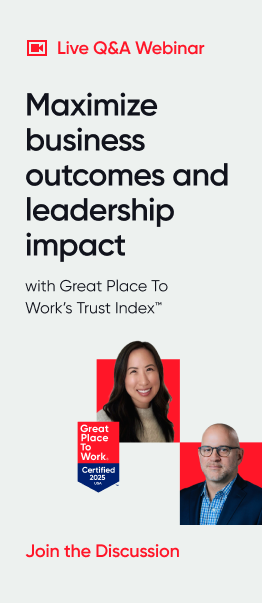DEIB, Diversity & Inclusion, Employee Experience
An ally is a partner, a person who has your back.
Whether on the playing field or in a courtroom, an ally works alongside you to reach shared goals. They won’t leave or let you down. They’re committed.
What does it mean to be an ally in the workplace?
Allyship in the workplace means using your personal privilege to support colleagues from historically marginalized communities. Allies wield their influence to amplify the voices and elevate the employee experience of their underrepresented coworkers. These efforts promote greater diversity, equity, inclusion and belonging (DEIB) throughout the company.
“You’re lending your power, lending your privilege, lending your access to someone who may or may not have the same privileges as you,” says Julian Lute, senior manager, strategic advisor at Great Place To Work.
While anyone can be an ally, they’re typically colleagues whose privilege comes from their sex (male), skin color (white), and/or position (seniority or high job ranking). Allies support employees who don’t have the same advantages. They could be women of color, LGBTQ+ or members of another minority group.
Whether formally or informally, a workplace ally builds partnerships that raise awareness, offer mentoring, and advocate on behalf of marginalized coworkers. These actions help those groups feel heard, valued, and respected.
The word “ally” comes from the Latin word alligare, which means to bind to. This significance isn’t lost on Tony Bond, EVP, chief diversity and innovation officer at Great Place To Work.
A true ally doesn’t come and go, Tony says, but is bound to those they are supporting and amplifying. True allyship merges long-term advancement, mutual interests and resource sharing.
“It’s a dynamic exchange of interests and resources,” Tony says. Allyship is dynamic because how to be an effective ally changes depending on the situation.
Allyship in the workplace starts with an inclusive company culture
So exactly what does it mean to be an ally? The allyship definition in the workplace takes on a more nuanced meaning because of the power differential at play. In a professional setting, an ally typically holds more power, but with that power comes both the ability and responsibility to foster a company culture where people can speak freely.
“If things aren’t going right, you should have the kind of workplace where anyone can say, ‘Hey, this isn’t quite working for the good of the company or for the good of the program,’” Julian says. “I think you need to have something like that before you just say, ‘Hey, look, allies, go out and start speaking up for people.’”
Senior executives with the power to alter policies can support this sort of workplace culture by listening and learning. They should note who is not being included, and those whose voices carry the least weight. Senior executives have the clout to effect change among their peer group, who likely see them as more objective and authoritative than marginalized employees.
Still, a company with lofty goals but no employee buy-in won’t go far. Support must come from the top down and the bottom up. It starts with the desire to make your company inclusive and equitable. Once leaders are more visible about their allyship, this creates a safe space for other leaders and colleagues to do the same
What is allyship in the workplace for staff throughout the company, and how can every person make a difference? There’s no clear blueprint, so you should weigh each scenario carefully. Let the relationships you’ve built over time inform your actions.
Different scenarios of allyship could be:
- Witnessing new mothers struggling to find a private, clean room to pump breast milk, then you might realize this is a common problem and advocate on their behalf
- Asking someone of a different gender or race to join you in conducting a job interview, which could lead to more inclusive hiring practices and greater diversity
- Highlighting the achievements of a mentee – which strengthens their reputation, sense of belonging, and potential for promotion
- Or inviting a coworker to collaborate on an important project, giving them more visibility to senior leaders.
Whether placing more women in management or supporting the LGBTQ+ community, allies share your goals and give you access to the resources needed to reach them. Shared connections teach you about the needs that exist within that group. Such experiences are the first steps to becoming a trusted ally.
These significant acts also promote a psychologically safe workplace for all:
- Calling a colleague by their preferred pronoun
- Asking that every staffer in a meeting be given the chance to speak
- Speaking for those who can’t or won’t.
Each action may be small, but combined they foster a company culture that’s open and receptive to new ideas and constructive criticism. Allyship as a diversity and inclusion tool in the workplace promotes equity for minority players.
5 Ways to be an ally at work
1. Listen more than you speak
An effective ally takes notice and listens, and seeks out opportunities to learn. If you want to support Black women, for instance, look for an Employee Resource Group that you can sponsor or learn from. Attend networking and community events to gain a clear picture of the challenges your colleagues face. (But first make sure your presence is welcome at these functions.)
Deliberate, everyday interactions with colleagues and community members also instill trust and knowledge. “Start by looking close to you,” Tony says. “Who is in close proximity to you that may need support?”
If you live near many people of a certain race/ethnicity, the proximity alone helps you form better relationships and understanding so you can offer tailored, long-term support.
2. Mentor others
Your place of privilege doesn’t mean you didn’t work hard to get there, but it does mean you have the power to coach others.
Let’s say your firm just hired its first Latina engineer. Sure, that increased office diversity, but does this new team member feel like she can share her ideas confidently in a room full of older white men? Does she feel included in conversations and like she belongs in your workplace? When you don’t look like anyone else around you, you’re prone to feeling like an outsider or imposter.
This is your chance to step in. Validate her perspective and contributions during meetings. Invite her to networking functions. Have her join a notable project that demonstrates and develops her skills. Nurture this relationship, because her continued success is a big win for your entire company and industry.
3. Share the spotlight
Look around your next meeting or conference and survey who’s not there. Are there enough women in the boardroom? Is today’s keynote speaker the third 60-year-old man in a row? Do the panels feature voices from diverse backgrounds that vary in race, class, gender, sexual orientation, neurodiversity and so much more?
Share your access and opportunities. If you’re a leading expert in your field, chances are you’ve been asked to present formally on many occasions. The next time this happens, suggest an employee who is a member of a marginalized group instead. Keep current on the interesting research being conducted by your colleagues – their work deserves to be heard, too.
4. Recognize – and correct – exclusion
“You need people that really understand how inclusion can happen and what it looks like when inclusion is not happening,” Julian says. “You have to have people that are learning, thinking about this, and have it top of mind so that we’re making sure that we’re keeping lots of different people in mind as we think about how we do things.”
One prime example: At an event Julian hosted, a friend pointed out the need for visual cues to indicate what’s happening and a microphone, which aid those who are hard of hearing. The friend’s circle includes people with physical disabilities, so she naturally served as an ally for this group.
5. Be strategic in your advocacy
Just like you can’t donate to every worthy cause, an ally can’t effectively champion every underrepresented group. Pick and choose the communities you know best or are most interested in helping.
“Allyship allows you to get in the game even if you’re not of that group,” Julian says.
“True allyship is almost like I’m a constituent of this group, in which I stand with and exercise voice” Tony says.
But allyship in the workplace is not one size fits all. Within the same marginalized group, members will differ in their experiences and views. If a person who goes by “they/them” pronouns has grown weary of always having to correct others, they’d probably appreciate your vocal support on their behalf. Yet others might prefer to fend off microaggressions for themselves and find this type of intervention offensive.
See where your singular voice can serve others the most.
Show job seekers they can expect a great workplace culture
Do you see great examples of allyship in your workplace? Earn Great Place To Work Certification™ to show future employees that your company is a great workplace. For more timely company culture tips, subscribe to our newsletter.
Turn culture insights into business wins
Let the Trust Index™ Survey reveal your workplace’s hidden strengths and areas for growth. Start transforming today.











